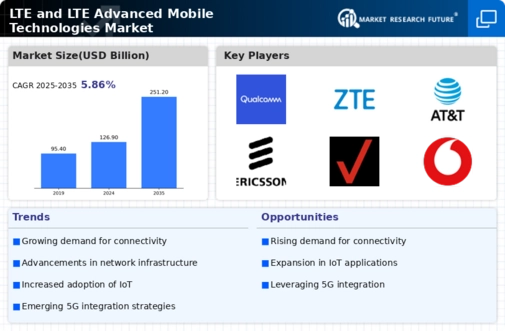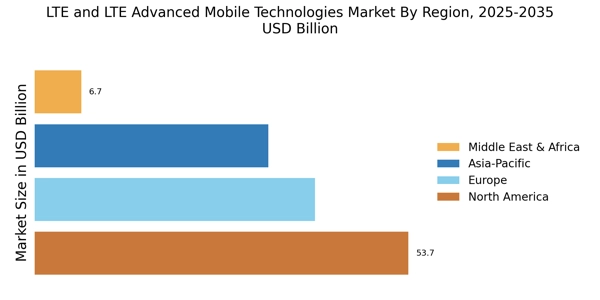Emergence of 5G Technologies
The LTE and LTE Advanced Mobile Technologies Market is currently positioned at a critical juncture with the emergence of 5G technologies. While 5G is set to revolutionize mobile communications, LTE and LTE Advanced technologies remain essential for providing seamless connectivity during the transition period. Many operators are adopting a hybrid approach, leveraging existing LTE networks while gradually integrating 5G capabilities. This strategy not only ensures continuity of service but also allows for a smoother migration to next-generation technologies. As a result, the LTE and LTE Advanced market is expected to maintain its relevance and growth, even as 5G becomes more prevalent.
Increasing Mobile Data Consumption
The LTE and LTE Advanced Mobile Technologies Market is experiencing a surge in mobile data consumption, driven by the proliferation of smartphones and mobile applications. As users demand higher data rates for streaming, gaming, and social media, mobile network operators are compelled to enhance their infrastructure. Reports indicate that mobile data traffic is expected to grow exponentially, with estimates suggesting a compound annual growth rate of over 30% in the coming years. This trend necessitates the deployment of LTE and LTE Advanced technologies, which offer improved bandwidth and lower latency, thereby catering to the evolving needs of consumers and businesses alike.
Advancements in Network Infrastructure
The LTE and LTE Advanced Mobile Technologies Market is significantly influenced by advancements in network infrastructure. The transition from 4G to LTE Advanced technologies enables operators to provide enhanced services, including carrier aggregation and improved spectral efficiency. These advancements not only optimize existing networks but also facilitate the deployment of new services such as ultra-reliable low-latency communications (URLLC). As operators invest in upgrading their infrastructure, the market is likely to witness a robust growth trajectory, with projections indicating that LTE Advanced technologies could account for a substantial share of mobile subscriptions by 2026.
Growing Demand for Enhanced Mobile Services
The LTE and LTE Advanced Mobile Technologies Market is witnessing a growing demand for enhanced mobile services, including high-definition video streaming, online gaming, and real-time applications. Consumers are increasingly seeking faster and more reliable connections, prompting service providers to invest in LTE and LTE Advanced technologies. Market data suggests that the number of LTE subscriptions has surpassed 4 billion, indicating a strong consumer preference for high-speed mobile services. This demand is likely to drive further investments in network expansion and technology upgrades, ensuring that operators can meet the expectations of their customer base.
Regulatory Initiatives Supporting Network Development
The LTE and LTE Advanced Mobile Technologies Market benefits from various regulatory initiatives aimed at supporting network development and expansion. Governments and regulatory bodies are increasingly recognizing the importance of robust mobile networks for economic growth and social connectivity. Initiatives such as spectrum allocation and funding for infrastructure projects are facilitating the deployment of LTE and LTE Advanced technologies. These regulatory frameworks not only encourage competition among service providers but also promote innovation in mobile services. As a result, the market is poised for sustained growth, driven by favorable regulatory environments that support the advancement of mobile technologies.


















Leave a Comment